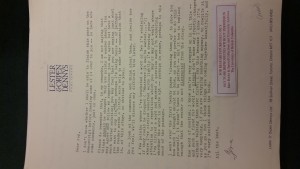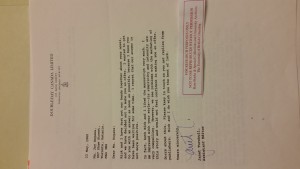Hello readers,
We have been reading and discussing the book Obasan by Joy Kogawa in depth in our recent ASTU class. The book follows the prospective of the Japanese-Canadian protagonist, Naomi and her journey of growing up in post World War Two era of Canada where racism towards Japanese and poverty is prominent. The book is especially important in Canadian literature today not only because it is one of the few books that wrote about the hardship and segregation Japanese-Canadian faced but also the setting of the book is right here in B.C.
Just last week, our ASTU class went to the rare book collection library located at the basement of Irving. K Library in UBC and we had the honor to look into Joy Kagawa’s archive. I have a better understanding of how the book came into being. Her achieve is packed hundreds of folders and within them holds numerous of fan letters, fan art, personal notes, pictures, recommendation letters and more but what stood out the most to me was the amount of rejection letters from different editors that she received. Never would I thought such renowned literature and commercially successful book would be so harshly critised.
I read a few of the letters and some of them stated that “it [the book] lack flow and its character development is dull” or even said that this book” lacks market in a commercial prospective” and doesn’t know how they would advertise/market this book(picture attached below). I am immensely surprised by the negative comment and is disappointed by the lack of enthusiasm of the editors. Despite the fact that the characters in this book are fictional, the storyline and all other details are based upon real life events, in detail described the hardship Japanese-Canadian felt during that period. It is evidence that the editors do not give much attention to this part of history because if they do, more books on the history of Japanese-Canadian would be published. This book to me is a piece of history that more people needs to know about.
I must confess before reading this book, I do not know much about the history of Japanese-Canadian, we do not discuses this topic in high school nor is there much debate over this topic in public today. I can go on and on about First Nations groups and residential schools but hardly know anything about Japanese-Canadian history. I believe what happened to the Japanese-Canadian are not being voiced out or recognized enough compared to First Nation history. If we do not educate children today on what happened in the past, this part of history would be completely wiped clean.
The book Obasan gave me a new prospective towards Canada and its history. I got to know more about how Canada came into what it is today; the process, events and bloodshed that took to create what I am enjoying now did not come easily. I wouldn’t say this book completely destroyed the perfect picture of Canada that’s painted in my head but it certainly resonated negatively on me. This book showed me another side of Canadian history that not many people know about, it gave me more information on its not-so-glamorous past.
I hope you enjoy my blog and have an awesome weekend!


